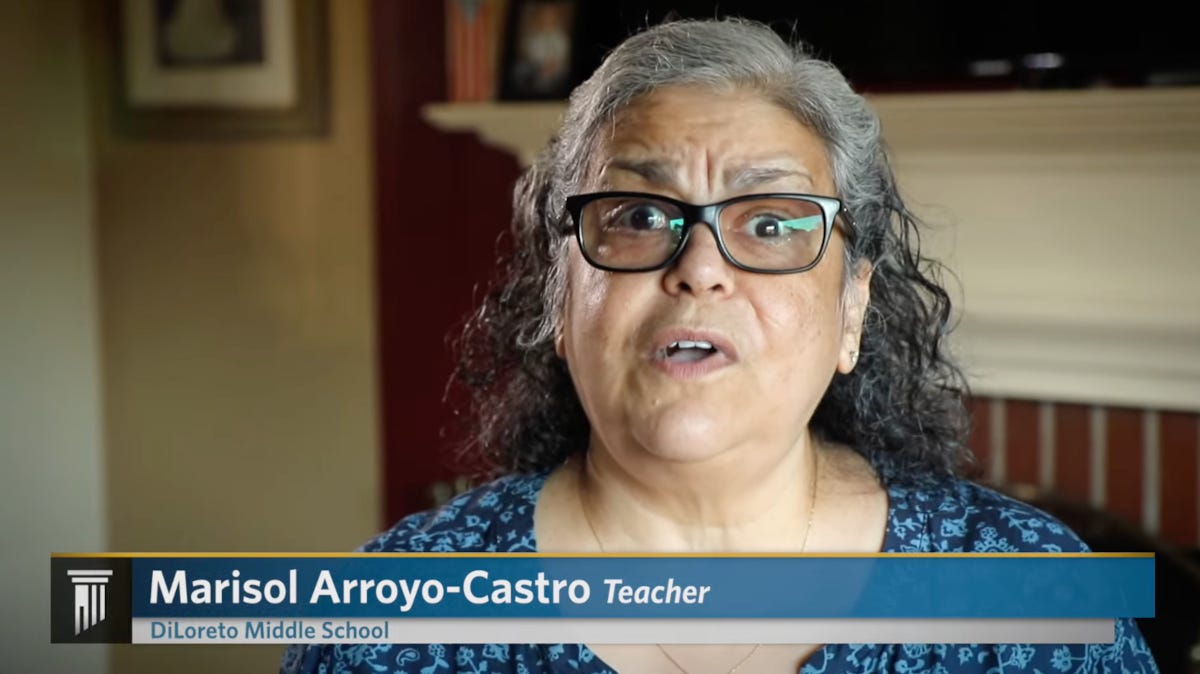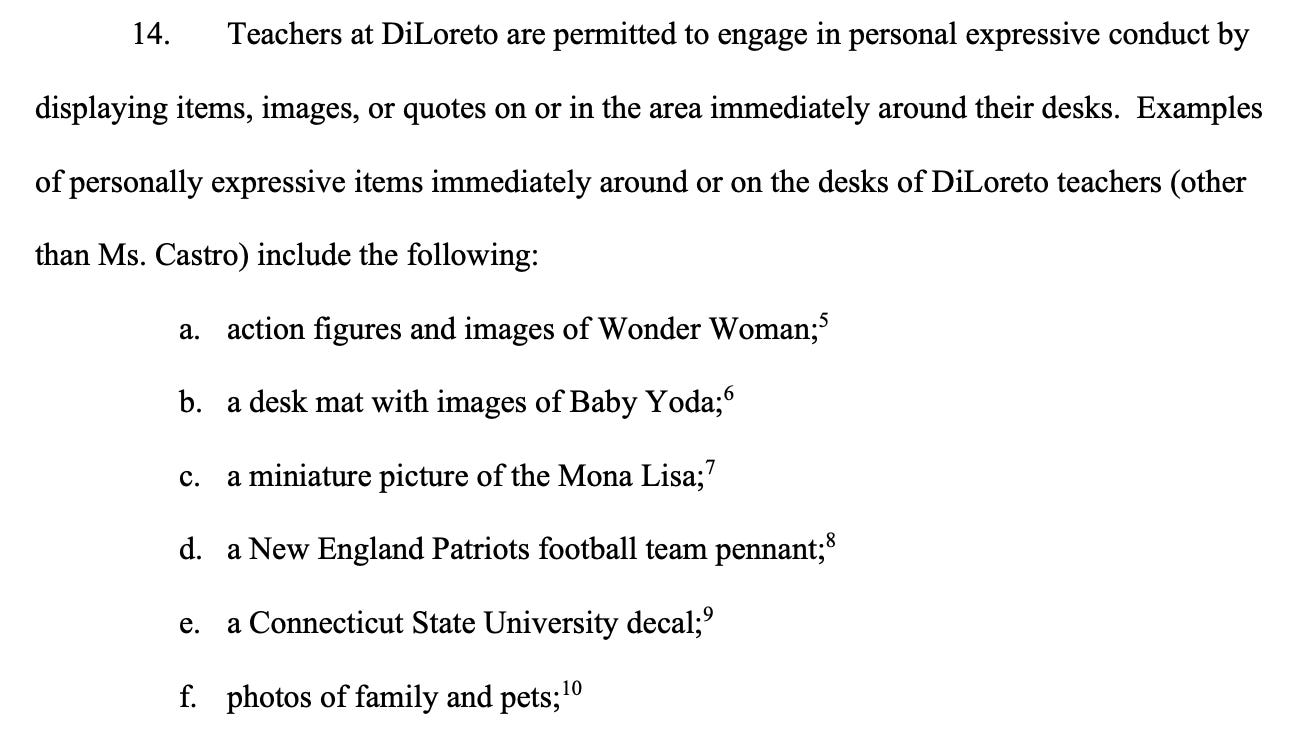Federal judge rules against defiant teacher who refused to remove crucifix from classroom
Marisol Arroyo-Castro’s lawsuit backfired as the court reaffirmed that public schools are not churches
This newsletter is free and goes out to over 23,000 subscribers, but it’s only able to sustain itself due to the support I receive from a small percentage of regular readers. Would you please consider becoming one of those supporters? You can use the button below to subscribe or use my usual Patreon page!
A federal judge has thankfully ruled against a public school teacher who demanded the right to keep a crucifix up in her classroom, then sued when the district punished her for it.
This situation centers around Marisol Arroyo-Castro, who worked as a teacher for over three decades, spending the past two decades teaching elementary and middle school in the Consolidated School District of New Britain, Connecticut.
Earlier this year, though, she was put on paid leave after she placed a Christian cross on her classroom wall, right beside her desk at the bottom of a whiteboard, and refused to remove it.
The cross had been in her DiLoreto Elementary and Middle School classroom for a decade and no one seemed to notice—though when she was teaching younger kids, it’s possible many of them had no clue what the symbol meant—but that changed when she got switched from 4th grade to 7th grade in the fall of 2024 and hung it up in her new room.
She would later explain that she needed the cross to stay calm:
Having the crucifix in her view at her desk brought Ms. Castro daily calm. Throughout her school days, looking at the crucifix provided her with peace and strength, especially when the (already stressful) task of teaching young students proved particularly challenging. During her lunch breaks, rather than going to the teachers’ lounge, she would remain at her desk, look at the crucifix, and pray.
All of that is fine, but there was no reason she couldn’t keep the cross in her office, or in her car, or inside her desk where she could pull it out as needed when students had left the classroom.
In December of 2024, the school’s vice principal sent her an email to set up a meeting to discuss the cross display. It wasn’t a disciplinary meeting; it was more of a “hey, you can’t do this, so we just wanted to let you know” meeting. A union rep also attended alongside her.
The day after they all met, the vice principal followed up with a summary of what they discussed:
… During the meeting, which was attended by [your union representative], I shared that any permanent displays of religious symbols are prohibited from public schools, based on the First Amendment of the United States Constitution. I shared the cross you have displayed in your classroom behind your desk must be taken down by Monday. You inquired if you could “think about it or pray on it,” which I replied that you could, however, it would not change the outcome of the meeting. Your next question was, “what if I don’t take it down?” I replied that it would lead to insubordination and disciplinary measures. I understand that the conversation and situation is difficult and I thank you in advance for complying with the expectation to remove the permanent religious display as public schools may not erect any type of religious display on school property. I will stop by your room on Monday at 8:00 am to observe if the cross is still displayed. Thank you and have a great weekend.
That was about as harmless and straightforward as you’d expect.
But Arroyo-Castro didn’t take the cross down. So the administration gave her another chance. They just asked her to put it somewhere where it wasn’t shoved in kids’ faces, like inside the desk or on the legs of her desk, where she could take it out whenever she needed it during her private time.
She refused. Her lawyers later argued “other DiLoreto teachers have not been forced to hide their personal items under their desks.” What kind of personal items? A Baby Yoda desk mat. A banner for a football team. A college decal. Photos of their families. Some even had religious icons like a coffee mug with a Bible reference… and a “picture of Santa Claus.” (Seriously, they said that.)
(Ironically, when they submitted a picture of the coffee mug—you can see it here on page 8— the Bible verse could barely be seen in the image—a fact the judge later noted.)
But she eventually caved and agreed to take it down… only to receive a warning from God:
As soon as she put her hand on the crucifix to move it, Ms. Castro felt sick and grew distraught. The other attendees left her sobbing only minutes before a scheduled parent-teacher conference.
Ms. Castro left the crucifix under the desk that night. But the next morning, Wednesday, December 11, 2024, Ms. Castro returned the crucifix to its place on the wall. She did so out of personal conscience and sincere religious conviction that to do otherwise would be an affront to her faith. Ms. Castro informed the Defendants of her decision.
That’s when she was finally placed on paid leave. She wasn’t listening. She refused to compromise. The school had no other choice. They gave her the option to return days later but only if she agreed to remove the cross. She refused to do that, too. In fact, she told them the Supreme Court’s decision in Kennedy—the case about the show-boating Christian football coach who demanded the right to hold his attention-seeking prayer gatherings at midfield after games—applied to her here.
… the Court concluded that the football coach’s postgame prayer at a time when coaches were free to attend to personal things was constitutionally protected—despite the fact that students could see his private religious expression.
The school didn’t buy it. And by the end of January, Arroyo-Castro had chosen not to return to the district.
That’s also when she filed a lawsuit against the district with the help of the conservative legal group First Liberty Institute.

To be clear, no one was suggesting she was proselytizing in the classroom, only that she was indirectly pushing religion on kids by putting up a religious symbol in class. It would be completely inappropriate if a Satanist did it. It would cause hissy fits across conservative media if a Muslim teacher did it. And it wasn’t okay here either.
If you can’t tell the difference between a cross on the wall and a Yankees pennant, then you don’t have any business being a teacher.
In response to all this, the district said they were just following the law. Yes, other teachers had personal items in their classrooms, but the district wasn’t treating Arroyo-Castro any differently from them. If other teachers put up inappropriate items, they would also be reprimanded for it. The fact that it never happened wasn’t evidence of unfair treatment against her, they said, adding that no one else had given them reason to take down personal items: “Because no teachers have displayed crucifixes in their classrooms at DiLoreto, Defendants admit that they have not had occasion to issue discipline for such actions.”
The district also took issue with her claim that the crucifix in her classroom was “small.” They also denied that she had “been pressured by Defendants to resign or retire early and sign an agreement not to sue the District.”
Now, nearly a year after this drama took place, a federal judge has finally weighed in on the matter.
On Monday, U.S. District Judge Sarah F. Russell (a Biden appointee) ruled that the school district had every right to punish Arroyo-Castro for her insubordination and that the promotion of Christianity in her classroom was indeed unconstitutional.
Russell wrote in her decision that the cross wasn’t just passive. Two students “complained that Ms. Castro was exposing students to religion in the classroom… and also said that Ms. Castro was making religious comments to students in the classroom.” That, apparently, is why the administrators took action in the first place. (An independent report from the school district found that she had allegedly said things like “I hope papa God helps you with your lies” or “go find God” when she was disciplining students for bad behavior.)
She also said the Kennedy decision didn’t apply here. Coach Joe Kennedy, the Supreme Court said, was acting during a time when coaches could deal with personal things despite being on the clock. Arroyo-Castro was on the clock as a teacher. Not the same thing.
Unlike the students in Kennedy, who were engaged in other activities while the coach prayed, Ms. Castro’s students received the religious message when they were required to be present in the classroom receiving instruction from Ms. Castro.
The judge noted in a footnote that even Kennedy’s lawyers admitted a teacher who prayed in class “during instructional time” would be violating the law because she was on the clock.
Russell concluded:
Under these circumstances, based on the existing factual record, I conclude that Ms. Castro is unlikely to prevail on her claim that her display of the crucifix on the wall of the classroom constitutes speech as a private citizen rather than pursuant to her job duties as a teacher. Therefore, I conclude she is not likely to prevail on her free speech claim.
The bottom line is that Arroyo-Castro has a choice: She can return to the classroom and play by the rules without the crucifix on the wall… or just admit that pushing her religion on kids matters more to her than educating them. She’s clearly going with the latter option.
She and her lawyers were furious, but they didn’t explain what the judge got wrong:
“Today’s decision flies in the face of clear Supreme Court precedent,” said Keisha Russell, Senior Counsel at First Liberty Institute, which represents Castro. “We will appeal and continue to fight for Marisol’s religious liberty rights.”
Castro expressed disappointment with the ruling.
“I am extremely disappointed with the decision by the court,” Castro said. “I still hope that I will be able to return to the classroom and continue to invest in the lives of students as I have my whole teaching career.”
She’s always been “able to return to the classroom.” But it’s clear she’s not interested in doing that unless she gets to treat her classroom as a church. So too bad.
It’s the right decision and a sharp rebuke to Christian teachers who think they can get away with anything.
This case isn’t just about a cross on a wall. It’s about how Christian Nationalists have a fundamental misunderstanding of the boundaries of faith in a secular space. Arroyo-Castro’s refusal to follow the law wasn’t an act of religious courage. It was an act of arrogance.
She wasn’t punished for being Christian. She was disciplined for deciding that her personal faith could override the Constitution and the rights of every child in her classroom.
The school district acted responsibly and patiently. They offered compromises. They didn’t mock her faith. They didn’t humiliate her. They just did their jobs—something she refused to do. It took a federal judge to step in and remind her (and her lawyers) that public schools aren’t churches and teachers aren’t pastors. The moment a classroom becomes a prsonal pulpit, the students who don’t share the teacher’s beliefs become outsiders in their own learning spaces.
There’s a movement right now trying to further destroy the wall of separation between church and state. The court’s decision stops that effort cold, at least in this case. It shouldn’t be an act of courage to say that public education must remain religiously neutral, and no teacher’s faith grants them a higher authority than the Constitution itself, but it sure feels that way.




I am deeply suspicious of anyone who needs to post a replica of an ancient Roman torture device in her classroom to remain calm. Unfortunately, these things are always a win-win for the Christians who keep trying to force their religion into the public school classrooms. They either get away with it, or they get to play the poor persecuted victims of the godless left.
Looking at a bleeding man nailed to a torture/execution device brought her peace, calmed her and gave her strength? And she thought that such a sigil was perfectly appropriate to share with her non-Catholic/nonreligious children?
She's mentally ill. This woman needs professional help.